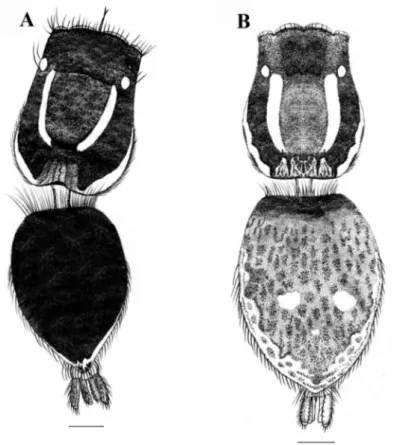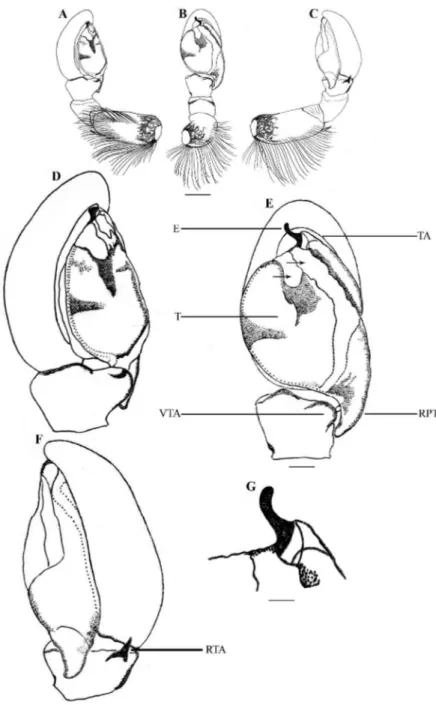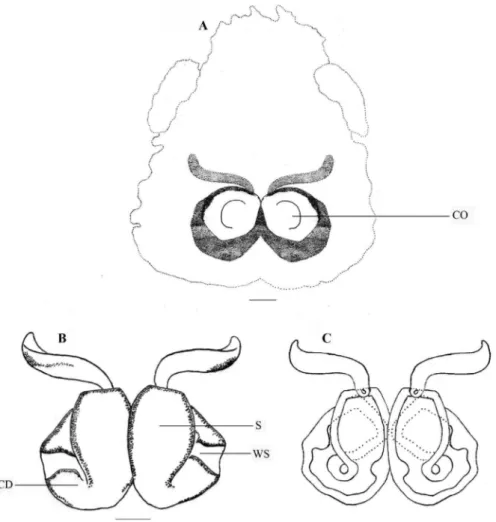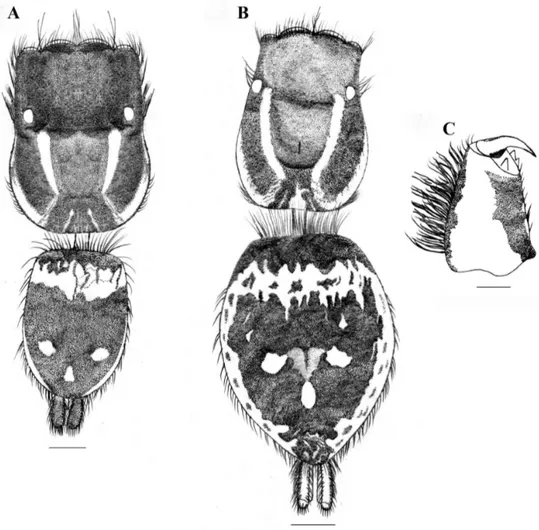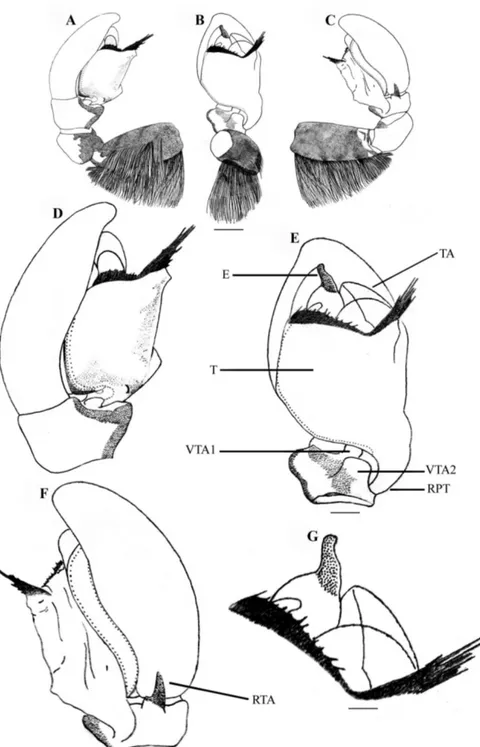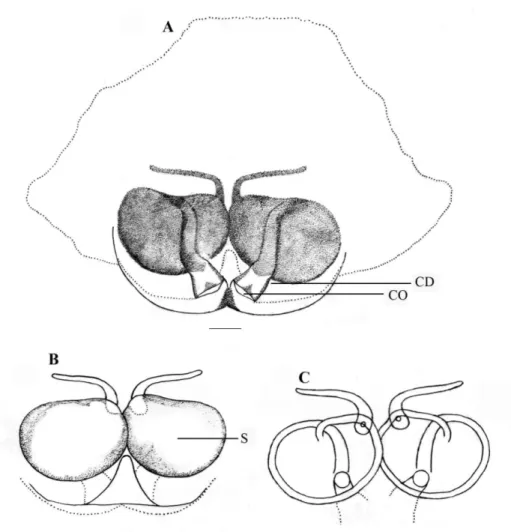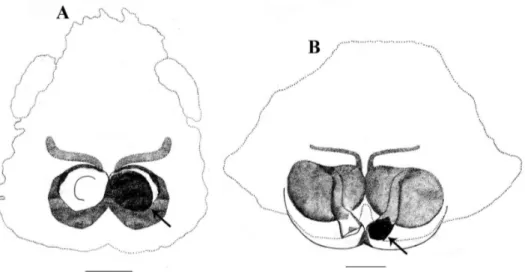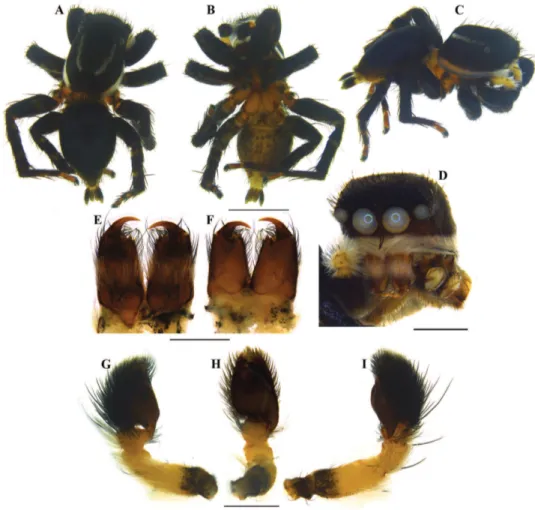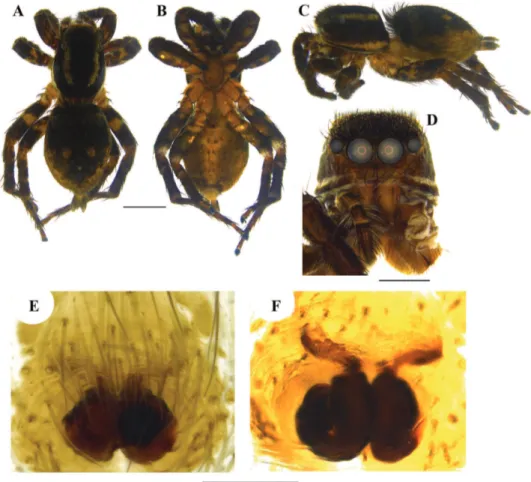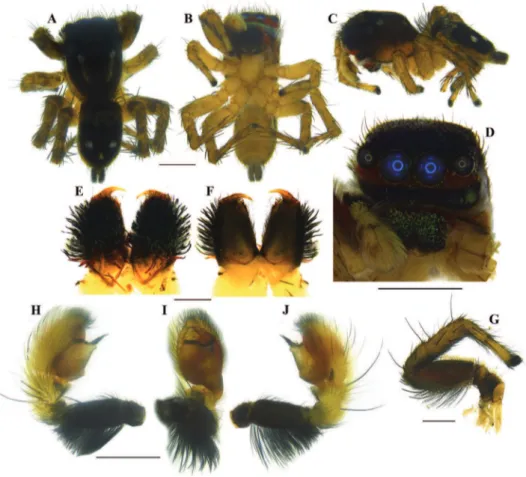Description of new species of Stenaelurillus Simon, 1886 from the Western Ghats... 63
Description of new species of
Stenaelurillus
Simon,
1886 from the Western Ghats of India with the
redescription of
Stenaelurillus lesserti
Reimoser,
1934 and notes on mating plug in the genus
(Arachnida, Araneae, Salticidae)
Pothalil A. Sebastian1, Pradeep M. Sankaran1, Jobi J. Malamel1, Mathew M. Joseph1
1 Division of Arachnology, Department of Zoology, Sacred Heart College, hevara, Kochi, Kerala 682 013, India
Corresponding author:Pradeep M. Sankaran (pradeepmspala@redifmail.com)
Academic editor:J. Miller | Received 7 July 2014 | Accepted 28 February 2015 | Published 26 March 2015 http://zoobank.org/0B218395-5DD8-45A6-B91E-90892E115C6E
Citation: Sebastian PA, Sankaran PM, Malamel JJ, Joseph MM (2015) Description of new species of Stenaelurillus
Simon, 1886 from the Western Ghats of India with the redescription of Stenaelurillus lesserti Reimoser, 1934 and notes on mating plug in the genus (Arachnida, Araneae, Salticidae). ZooKeys 491: 63–78. doi: 10.3897/zookeys.491.8218
Abstract
A new species of the jumping spider genus Stenaelurillus Simon, 1886, S. albussp. n., is described from the Western Ghats of India, one of the biodiversity hotspots of the world. Detailed morphological descrip-tions, diagnostic features and illustrations of copulatory organs of both sexes are given. Detailed redescrip-tion, diagnosis and illustration of S. lesserti Reimoser, 1934 are provided. he occurrence of a mating plug in the genus is reported.
Keywords
Mating plug, new species, paternity, redescription, Western Ghats
ZooKeys 491: 63–78 (2015) doi: 10.3897/zookeys.491.8218 http://zookeys.pensoft.net
Copyright Pothalil A. Sebastian et al. This is an open access article distributed under the terms of the Creative Commons Attribution License (CC BY 4.0), which permits unrestricted use, distribution, and reproduction in any medium, provided the original author and source are credited.
RESEARCH ARTICLE
Launched to accelerate biodiversity research
Pothalil A. Sebastian et al. / ZooKeys 491: 63–78 (2015)
64
Introduction
he salticid spider genus Stenaelurillus, which is considered a senior synonym of
Philotheroides Strand, 1934 (Prószyński 1984), was erected by Simon in 1886 to ac-commodate three species: S. nigricaudus Simon, 1886 (from Senegal), S. nigritarsus
Simon, 1886 (from Algeria), which later became a junior synonym of S. nigricaudus
(Szűts & Scharf, 2005) and S. triguttatus Simon, 1886 (from Tibet). Wesolowska (2014) reviewed the Asian species of the genus and synonymised S. hainanensis Peng, 1995 with S. minutus Song & Chai, 1991 and considered S. setosus horell, 1895 as a
nomen nudum. Presently the genus has 27 valid species, mostly from Africa (21 species) with only two representatives from India, S. lesserti Reimoser, 1934 (known from both sexes) and S. sarojinae Caleb & Mathai, 2014 (known only from female) (World Spi-der Catalog 2014). he current paper provides the description of a new species of the genus Stenaelurillus from the Western Ghats, one of the biodiversity hotspots of the world (Myers et al. 2000), in the Kerala region of southern India with the redescrip-tion of S. lesserti Reimoser, 1934.
Material and methods
he specimens were preserved in 70% ethanol and studied under a Zeiss Stemi 2000-C stereomicroscope. All measurements are in millimetres (mm) and were made with an ocular micrometer. Length of palp and leg segments are given as: total (femur, patella, tibia, metatarsus (except palp), tarsus). Spine positions are as follows: prolateral, dorsal, retrolateral and ventral. Comparison of the new Stenaelurillus species with all other de-scribed species is based only on available literature. Drawings were made by the aid of a drawing tube attached to the microscope. Field photos were taken with Canon EOS 6D with Canon Macro photo lens MP-E65 mm 1:2.8 lens attached. he micropho-tographic images were taken by Leica DFC295 digital camera attached to Leica M205 C stereomicroscope with the software package Leica Application Suite (LAS), version 4.3.0. All specimens are deposited in a reference collection housed at the Division of Arachnology, Department of Zoology, Sacred Heart College, hevara, Cochin, Kerala, India (ADSH).
Abbreviations
Description of new species of Stenaelurillus Simon, 1886 from the Western Ghats... 65
Taxonomy
Salticidae Blackwall, 1841 Aelurillinae Simon, 1901
Stenaelurillus Simon, 1886
Diagnosis. Medium sized spiders. Prosoma of all the known Stenaelurillus species has two white transverse stripes. Both male and female have strong bristles on the ocular area. Male palp with a short, not coiled and visible embolus, and tegulum with char-acteristic retrobasal process. RTA is simple and strongly sclerotized. Epigyne is simple, with thick-walled copulatory openings and short copulatory ducts, and is often ac-companied by accessory glands (Szűts and Scharf 2005).
Type species.Stenaelurillus nigricaudus Simon, 1886, by original designation.
Distribution. Africa, Asia (World Spider Catalog 2014).
Stenaelurillus albus sp. n.
http://zoobank.org/29A9E0C0-1472-47A2-A9BB-22B4D84C8C01
Figs 1A–B, 2A–G, 3A–C, 7A, 8A–I, 9A–F
Type material. Holotype: Male (ADSH 83503Ai): India, Kerala, Ernakulam, Kurisumudi (10°12'33.36"N, 76°30'08.85"E) in Malayatoor (10°11'43.76"N, 76°29'48.45"E), 94 m. alt., Pradeep M. S., 04. XII. 2013, by hand; Paratypes: 8 fe-males, 6 males (ADSH 83503Aii), same data as holotype.
Diagnosis. Males of S. albus sp. n. can be separated from all other described congeners by uniformly dark dorsal opisthosoma without any pattern (Figs 1A, 8A), paired creamy white areas at the anterior part of the bulbus, (Fig. 2E, arrows) and pal-pal femur with a single disto-dorsal spine (Figs 2A, 2C); females are most similar to S. abramovi Logunov, 2008 as both possess wide copulatory openings (Logunov 2008, Fig. 4 and herein Figs 3A, 9E), but can be distinguished by the presence of small and ‘vase’- shaped spermathecae (Figs 3B, 9F) and copulatory ducts with weakly sclerotized anterior part (Fig. 3B).
Pothalil A. Sebastian et al. / ZooKeys 491: 63–78 (2015)
66
Figure 1.Stenaelurillus albus sp. n. A Male habitus, dorsal view B Female habitus, dorsal view. Scale bars: A = 0.58 mm; B = 0.68 mm.
Description of new species of Stenaelurillus Simon, 1886 from the Western Ghats... 67
Figure 2.Stenaelurillus albus sp. n. Left male palp. A Palp entire, prolateral view B Same, ventral view
C Same, retrolateral view D Palp enlarged, prolateral view E Same, ventral view F Same, retrolateral view
G Embolic division of the bulb, ventral view. E = Embolus; RPT = Retrobasal process of tegulum; RTA = Retrolateral tibial apophysis; T = Tegulum; TA = Terminal apophysis. Scale bars: A–C = 0.34 mm; D–F
Pothalil A. Sebastian et al. / ZooKeys 491: 63–78 (2015)
68
Figure 3. Stenaelurillusalbus sp. n. Female copulatory organ. A Epigyne B, C Internal duct system. CO = Copulatory opening; CD = Copulatory duct, S = Spermatheca; WS = Weakly sclerotized part of copulatory duct. Scale bars: A = 0.11 mm; B–C = 0.03 mm.
Description of new species of Stenaelurillus Simon, 1886 from the Western Ghats... 69
Figure 4. Stenaelurillus lesserti Reimoser, 1934. A Male habitus, dorsal view B Female habitus, dorsal view C Male right chelicera, retrolateral view. Scale bars: A = 0.38 mm; B = 0.65 mm; C = 0.08 mm.
Pothalil A. Sebastian et al. / ZooKeys 491: 63–78 (2015)
70
Description of new species of Stenaelurillus Simon, 1886 from the Western Ghats... 71
Figure 6. Stenaelurillus lesserti Reimoser, 1934. Female copulatory organ. A Epigyne B, C Internal duct system. CO = Copulatory opening; CD = Copulatory duct; S = Spermatheca. Scale bars: A = 0.09 mm;
B–C = 0.07 mm.
Pothalil A. Sebastian et al. / ZooKeys 491: 63–78 (2015)
72
Figure 7. Stenaelurillus spp. Epigyne with mating plugs. A Epigyne of Stenaelurillusalbus sp. n. showing mating plug (arrow) B Epigyne of Stenaelurillus lesserti Reimoser, 1934 showing mating plug (arrow). Scale bars: A = 0.21 mm; B = 0.19 mm.
1010; tibia I 3004, II 1004, III 4133, IV 4143; metatarsus I 3003, II 3013, III 3234, IV 4054; tarsi I–IV 0000. Copulatory organ (Figs 3A–C, 9E–F): Spermathecae small with a characteristic vase- shape (Figs 3B, 9F). Copulatory opening wide (Figs 3A, 9E) and nearly half the size of the spermathecae. Anterior part of copulatory duct near the copulatory opening is weakly sclerotized (Fig. 3B).
Variation. Male: Body length 4.61–5.89 (n = 7). Female: Body length 5.43–6.82 (n = 8).
Etymology. he speciic epithet is an adjective and is derived from the whitish part of the tegulum: Latin Albus = white. Gender musculine.
Habitat. Rocky area covered with litter in a deciduous forest (Fig. 12A).
Distribution. At present known only from the type locality.
Stenaelurillus lesserti Reimoser, 1934 Figs 4A–C, 5A–G, 6A–C, 7B, 10A–J, 11A–F
Stenaelurillus lesserti Reimoser, 1934: 504, igs 25–26 (Description and illustration of
♂ and ♀); Prószyński 1984: 139 (Illustration of ♀); Wesolowska 2014: 248, igs 1A–B, 2A–F, 3A–D (Re-examined the original type series of S. lesserti; description and illustration of ♂ and ♀).
Description of new species of Stenaelurillus Simon, 1886 from the Western Ghats... 73
Figure 8.Stenaelurillus albus sp. n. A Male habitus, dorsal view B Same, ventral view C Same, prolateral view D Same, frontal view E Male chelicerae, dorsal view F Same, ventral view G Left male palp, prolateral view H Same, ventral view I Same, retrolateral view. Scale bars: A–C = 2 mm; D = 1 mm; E–F = 0.5 mm;
G–I = 0.5 mm.
Diagnosis. Males of S. lesserti Reimoser, 1934 can be separated from all other de-scribed congeners by a transverse fringe of very thin, hard projections resembling hairs at the anterior edge of the harder shield covering the bulbus (Figs 5D–G, 10H–J); females by the presence of unusually enlarged and kidney-shaped spermathecae and the relative position of the copulatory openings (Figs 6A–B, 11E–F).
Pothalil A. Sebastian et al. / ZooKeys 491: 63–78 (2015)
74
Figure 9.Stenaelurillusalbus sp. n. A Female habitus, dorsal view B Same, ventral view C Same, retro-lateral view D Same, frontal view E Epigyne F Internal duct system. Scale bars: A–C = 2 mm; D = 1 mm;
E–F = 0.2 mm.
Description of new species of Stenaelurillus Simon, 1886 from the Western Ghats... 75
Figure 10.Stenaelurillus lesserti Reimoser, 1934. A Male habitus, dorsal view B Same, ventral view
C Same, retrolateral view D Same, frontal view E Male chelicerae, dorsal view F Same, ventral view
G Male left leg I, prolateral view H Left male palp, prolateral view I Same, ventral view J Same, retrolateral view. Scale bars: A–C = 1 mm; D = 1 mm; E–F = 0.2 mm; G = 0.5 mm; H–J = 0.5 mm.
Pothalil A. Sebastian et al. / ZooKeys 491: 63–78 (2015)
76
Figure 11.Stenaelurilluslesserti Reimoser, 1934. A Female habitus, dorsal view B Same, ventral view
C Same, retrolateral view D Same, frontal view E Epigyne F Internal duct system. Scale bars: A–C = 2 mm; D = 1 mm; E–F = 0.5 mm.
Figure 12. Habitats of Stenaelurillus spp. A View of the type locality of S. albus sp. n. B View of the collection site of S. lesserti Reimoser, 1934.
retrolateral angle (Figs 5D–F); embolus short with blunt end, retrolaterally directed with prolaterally directed tip (Figs 5E, 5G); conductor apparently absent; terminal apophysis short, directed at ten o'clock position (Figs 5E, 5G). Tibia with two ventral apophyses (Fig. 5E); VTA 1 is the smallest; VTA 2 with a lattened end (Fig. 5E); both VTA 1 & 2 directed at one o'clock position (Fig. 5E); RTA simple with broad base, pointed end, directed at eleven o'clock position (Fig. 5F).
Description of new species of Stenaelurillus Simon, 1886 from the Western Ghats... 77
and one small, and retromargin with one large teeth. Fangs short, black. Maxillae and labium black. Opisthosoma widely oval; dorsum black with an anterior broad trans-verse white band and posterior three white spots, which together forming an inverted triangle; lateral opisthosoma pale yellow with several broken longitudinal black stria-tions while venter pale yellow without any striastria-tions or spots. Sternum and coxae pale yellow; coxa I retrolaterally black; all other leg segments pale yellow with black patches and narrow transverse black stripes. Palp: posterior 1/4th of femur black; rest of femur and other segments pale yellow. Body length 6.46. Prosoma length 2.97, width (at the middle) 1.86, height (at the middle) 1.49. Opisthosoma length 3.49, width (at the middle) 2.69, height (at the middle) 1.90. Eyes diameter: AME 0.41. ALE 0.22. PME 0.04. PLE 0.15. Eye interdistance: AME–AME 0.02. PME–PME 1.31. PLE–PLE 1.14. AME–ALE 0.05. ALE–PLE 0.38. ALE–PME 0.21. PME–PLE 0.16. Clypeus height at AMEs 0.27, at ALEs 0.44. Chelicera length 0.56. Measurements of palp and legs. Palp 1.5 [0.52, 0.25, 0.24, 0.49], I 3.28 [1.14, 0.58, 0.61, 0.44, 0.51], II 3.16 [1.12, 0.54, 0.58, 0.49, 0.43], III 5.49 [1.75, 0.84, 1.09, 1.14, 0.67], IV 5.13 [1.53, 0.66, 1.07, 1.26, 0.61]. Leg formula: 3412. Spination. Palp. 0100 0000 0000 2231; legs: femur I 0600, II 0700, III 2600, IV 0600; patellae I–II 1000, III–IV 1010; tibia I 1005, II 2004, III 4043, IV 4343; metatarsi I–II 2014, III 3324, IV 3323; tarsi I–IV 0000. Copulatory organ (Figs 6A–C, 11E–F): Copulatory opening is nearly diamond shaped (Fig. 6A) and placed near the posterior margin of the epigyne (Figs 6A, 11E). Spermathecae are much enlarged and kidney shaped (Figs 6B, 11F).
Variation. Male: (n = 4) Body length 3.24–3.80. Female: (n = 5) Body length 6.15–6.46.
Habitat. Rocky area having patches of grass and herbaceous vegetation in a semi-evergreen forest (Fig. 12B).
Distribution. India, Sri Lanka (Wesolowska 2014).
Distribution in India. Kerala (new record) and Tamilnadu (Reimoser 1934).
Note. Mating plugs, which are supposed to function as paternity protection de-vices (Uhl et al. 2010; Herberstein et al. 2012), are not very unusual in the animal kingdom and their presence have been described in a number of spider families in-cluding Salticidae. Mating plugs are reported in a total of 10 genera and 17 species of salticid spiders (Uhl et al. 2010). Mating plug was observed in the copulatory opening of the two Stenaelurillus species described in this paper. he left copulatory opening of both S. albus sp. n. and S. lesserti were found to be sealed with amorphous secretions (whether male or female origin is unclear) (Figs 7A–B, arrows). Compared to S. lesserti, the mating plug of S. albus sp. n. is more prominent and covering nearly the whole area of the left copulatory opening and the surrounding epigynal region.
Acknowledgements
Pothalil A. Sebastian et al. / ZooKeys 491: 63–78 (2015)
78
Dr. Jerzy Prószyński, Poland for his special consideration and encouragement through-out the work. We thank Dr. Norman I. Platnick, American Museum of Natural His-tory, New York and Dr. Gabriele Uhl, Allgemeine und Systematische Zoologie, Ger-many for providing literature support. he second author is indebted to Dr. A. V. Sudhikumar, Christ College, hrissur, Kerala for his valuable suggestions. hanks to Dr. M. K. Raju and Mr. Sam homas for their assistance in the ield. We extend our heartfelt thanks to Dr Jeremy A. Miller, he Naturalis Biodiversity Center, Nether-lands, Dr Dmitri V. Logunov, the Manchester Museum, University of Manchester, UK and an anonymous reviewer for their constructive comments on an earlier draft of the manuscript. We thank Chief Conservator of Forest, Kerala State Forest Division for permitting us to collect the specimens. We especially acknowledge Science and En-gineering Research Board (SERB) – DST, New Delhi for providing funding support under Major Research Project: No. SR/SO/AS-99/2012.
References
Caleb TDJ, Mathai MT (2014) Description of some interesting jumping spiders (Araneae: Salticidae) from South India. Journal of Entomology and Zoology Studies 2: 63–71. Herberstein ME, Wignall AE, Nessler SH, Harmer AMT, Schneider JM (2012) How efective
and persistent are fragments of male genitalia as mating plugs? Behavioral Ecology 23: 1140–1145. doi: 10.1093/beheco/ars088
Logunov DV (2008) A new species of the genus Stenaelurillus Simon, 1885 (Araneae: Salticidae) from Vietnam. Acta Arachnologica, Tokyo 57: 43–45. doi: 10.2476/asjaa.57.43
Myers N, Mittermeier RA, Mittermeier CG, Da Fonseca GA, Kent J (2000) Biodiversity hot-spots for conservation priorities. Nature 403: 853–858. doi: 10.1038/35002501
Prószyński J (1984) Atlas rysunków diagnostycznych mniej znanych Salticidae (Araneae). Wyzsza Szkola Rolniczo-Pedagogiczna, Siedlcach 2: 1–177.
Reimoser E (1934) Araneae aus Sud-Indien. Revue Süisse de Zoologie 41: 465–511.
Szüts T, Scharf N (2005) Redescriptions of little known jumping spider genera (Araneae: Salti-cidae) from West Africa. Acta zoologica Academiae Scientiarum Hungaricae 51: 357–378. Uhl G, Nessler SH, Schneider JM (2010) Securing paternity in spiders? A review on
occur-rence and efects of mating plugs and male genital mutilation. Genetica 138: 75–104. doi: 10.1007/s10709-009-9388-5
Wesolowska W (2014) A review of the Asian species of the spider genus Stenaelurillus (Araneae: Salticidae). Oriental Insects 47: 246–254. doi: 10.1080/00305316.2013.871823
